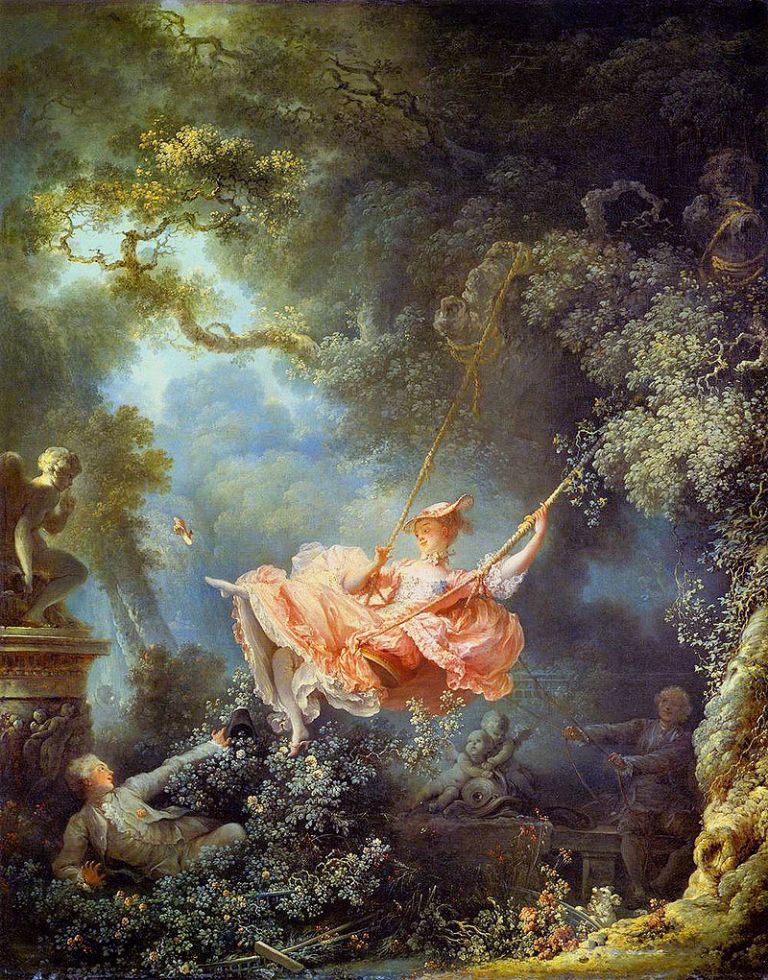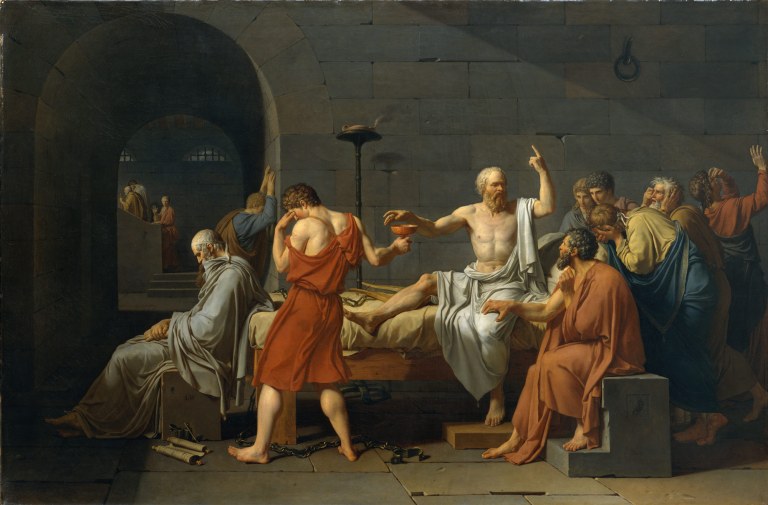Rococo Examples


Neoclassical Examples


Changing Morality
The Classical Era is drastically split between the earlier and later periods. This split shows up in the wild gap between the Rococo aesthetics of light, ethereal environments and airy subject matters and the later Neoclassical forms of rigid morality and historical themes. This can be explained as a difference between the expectations of art during these separate periods. Rococo art was created for the ranks of European nobility who strove to live the perfect “fete galante” lifestyle. During the rapid transition to Neoclassical art, the discoveries of Pompeii and Herculaneum brought about a new interest in the ancient world and its art forms (Gontar). This combined with the moral outrage expressed at Rococo art by the middle classes, who were appalled by its loose morality, Neoclassical art with its rigid morality of heroism, righteousness, and moral virtue spread like wildfire throughout the art community. This shift in morality was also facilitated by people’s fascination with Greek and Roman culture and ideologies, which would become even more apparent in European culture after the French Revolution, which can almost be seen as the ultimate Neoclassical uprising against the last vestiges of Rococo culture in France. Although, this revolution did not exactly embrace righteousness and moral virtue as vigorously (or even at all) in comparison with Neoclassical art.
Artistic Divide
Although all four pieces of art that I have selected for this blog are technically from the same era, anyone who did not know this would be hard pressed to spot any similarities between them. For example, the first two, Fragonard’s The Swing, and Watteau’s Pilgrimage to Cythera, both show pastel colors, faded and ethereal backgrounds, and fancifully dressed subject matters that show the idealized lifestyles of the nobility. On the other hand, the other two paintings, David’s Oath of the Horatii and The Death of Socrates, show sharp and focused shapes and colors that portray the intensity of this new style of art. The differing moral environments are clearly seen between these paintings, not just in their art forms, but also in their subject matters. For example the Lourve Museum describes The Oath of the Horatii as portraying a scene in the 7th century BC where, “the three Horatii brothers, chosen by the Romans to defy the Curiatii, the champions of the town of Alba, are swearing to defeat their enemies or die” (Lerouge). In comparison, the Pilgrimage to the Isle of Cythera is described as either depicting lovers departing or about to embark on a journey to the island of love. Likewise, the Swing depicts a fancifully dressed women swinging over her lurking lover (not exactly a moral lesson in history). Contrasting this painting, the Neoclassical The Death of Socrates does depict a historical lesson in morality, showing Socrates preparing to swallow poison and die rather than renounce his beliefs.
Overall, all of these paintings are considered masterpieces of their time; however, their times had drastically different perimeters concerning the classification of what was acceptable subject matter. I feel that all of these paintings are amazing in their own way; yet, I personally like the firmer definitions and artistic styles of the Neoclassical paintings as they are not as foggy and morally ambiguous as the Rococo paintings.
Works Cited
Gontar, Cybele. “Neoclassicism.” In Heilbrunn Timeline of Art History. New York: The Metropolitan Museum of Art, 2000–. http://www.metmuseum.org/toah/hd/neoc_1/hd_neoc_1.htm (October 2003)
Harris, Dr. Beth, Zucker, Dr. Steven. “Fragonard, The Swing.” Youtube Video. Khan Academy. n.d. Web. 27 Feb. 2016. https://www.khanacademy.org/humanities/monarchy-enlightenment/rococo/v/fragonard-the-swing-1767
Lerouge, Ophelie. “The Oath of the Horatii.” Department of Painting, The Louvre. n.d. Web. 27 Feb. 2016. http://www.louvre.fr/en/oeuvre-notices/oath-horatii
McCoy, Dr. Claire. “David, Oath of the Horatii.” Khan Academy. n.d. Web. 27 Feb. 2016. https://www.khanacademy.org/humanities/monarchy-enlightenment/neo-classicism/a/david-oath-of-the-horatii
Pomarede, Vincent. “Pilgrimage to Cythera.” Department of Painting, The Louvre. n.d. Web. 27 Feb. 2016. http://www.louvre.fr/en/oeuvre-notices/pilgrimage-cythera
Stein, Perrin. “Antoine Watteau (1684–1721).” In Heilbrunn Timeline of Art History. New York: The Metropolitan Museum of Art, 2000–. http://www.metmuseum.org/toah/hd/watt/hd_watt.htm (October 2003)
Stein, Perrin. “Jean Honoré Fragonard (1732–1806).” In Heilbrunn Timeline of Art History. New York: The Metropolitan Museum of Art, 2000–. http://www.metmuseum.org/toah/hd/frag/hd_frag.htm (October 2004)
“The Death of Socrates.” The Collection Online. The Metropolitan Museum of Art. n.d. Web. 27 Feb. 2016. http://www.metmuseum.org/collection/the-collection-online/search/436105
Thank you for this interesting post, Jason! I like the color in the pieces you chose. Overall, I think my favorite piece is Oath of the Horatii. It has visually appealing details, composition, lighting, and colors. The grim determination on their faces gives this painting an inspiring message. It is interesting how the different types of art have had different purposes. The rococo style seemed to be purely for enjoyment. The neoclassical style was loaded with strong moral messages. Today, art seems to be produced with vague details that leave room for you to draw your own meaning from it. Art is definitely more than just snapshots of scenes. It has a stories behind it.
I was curious to learn more about Death of Socrates. There are so many details in it–handcuffs on the floor, an abandon scroll and ink, visibly upset men, and sober and controlled men, to name a few. This page helped explain some of those details.
LikeLike
I find the story behind “The Oath of the Horatii” exciting. Three brothers from two separate families, coming together to fight for their respective homes. By itself it would have been a great tale, but the addition of a Horatii sister and a Curiatti sister marrying across family lines adds drama and high expectation of the outcome of the battle. Like his work “The Death of Socrates”, The Oath grasps a moment observed just before an historic event that captures the viewer, engaging them in the emotion of what is happening. Through the readings and blogs like yours I have come to appreciate David’s work.
LikeLike
The pieces you chose definitely show the distinction between the two styles very clearly. I like how you did a compare/contrast with the two styles and their extreme ideologies. Putting them side by side, one can definitely see the frivolity and questionable morality on the Rococo side, and the serious yet valiant heroics displayed on the Neoclassical side.
I, too, prefer both the subject matter and the style of the Neoclassical paintings. The Rococo style feels a bit shallow to me, there is definitely beauty to be found in the paintings, but they lack a depth in my opinion.
It is amazing to me how art can push the boundaries of mainstream acceptable societal norms and put something confrontational, morally questionable, or shocking for the time period right out there for everyone to see. You can see the bar being pushed in both styles-the sensual and morally questionable themes in Rococo as demonstrated in The Swing, and the gory or violent themes sometimes found in the Neoclassical style such as the The Death of Marat by Jacques-Louis David.
I like in Neoclassical works that the posture and expressions of the people in the painting tell so much about what is going on. For instance, in The Death of Socrates almost none of Socrate’s companions are looking at him. Their postures tell of their despondency, some not even able to look in his direction. The only one who is upright and impassioned is Socrates himself.
LikeLike